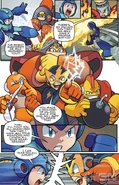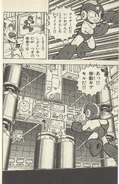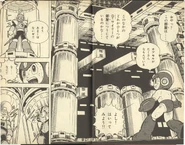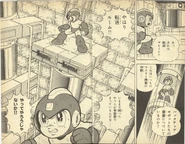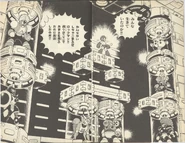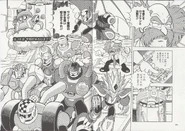| This article requires cleanup. You can help MMKB by improving it. |

Mega Man 3's boss rematch room.
A Boss Rush (ボスラッシュ) is a video game term used to refer for the occasion the player has to fight against the bosses of their respective game again, usually as a bonus mode or near the end of the game. This has become a tradition in most Mega Man games, where the eight bosses from the Stage Select Screen or previous Missions are fought again in the final stages. RPG games like the Mega Man Battle Network series also include rematches against previous bosses near the end of the game. The way a boss rush occurs changes depending of the game. Normally, such fights are held in a single room, but in a few cases, the bosses are fought in a gauntlet dotted throughout the final stages.
In some games, an explanation is given to the bosses getting resurrected. In Mega Man X8, the eight bosses are actually Guardroids imitating the bosses. In Mega Man X: Command Mission, it is strongly implied that Wild Jango (and presumably the other Maverick bosses) were cloned via Colonel Redips' DNA copy chip copying their data and resurrected that way, or at the very least his DNA was used with another New Generation Reploid. In the remake Mega Man Maverick Hunter X, X talks with Launch Octopus and believes that Sigma has brought their bodies back to life. Although revived, Launch Octopus (and presumably the other seven Mavericks) appeared to now only have a robotic-like personality, with him saying that he was ordered to fight. In the remake Mega Man Powered Up, the eight bosses are assumed to be Copy Robots due to having a different color palette and voice compare to the original and were used due to Mega Man having rescued or destroyed the original bosses. In Mega Man Zero 4 and Mega Man ZX, it is implied that Dr. Weil and Serpent (the latter via Model W) revived the Einherjar Eight Warriors and the Pseudoroids in order to stall Zero and Model ZX, respectively. In Mega Man ZX Advent, Master Albert revived the eight Pseudoroids by giving their spirits new bodies via both Model W (which at that point had its pieces merged together to form Ouroboros) and his own usage of A-Trans. On a related note, although not a true boss rush, the latter game has various Pseudoroids being rematched in various locations, with one character, Ward, strongly implying that their revival had to do with the presence of Model W.
Appearances
Mega Man series
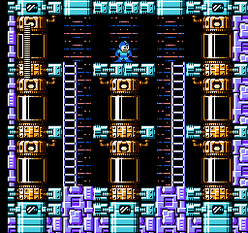
Mega Man 5's boss rematch room.
In the first Mega Man game, Mega Man fights against the six Robot Masters again in the final stages, originally being divided in two groups: In the second Wily Castle stage, Mega Man faces Cut Man and Elec Man. In the last stage, Bomb Man, Fire Man, Ice Man and Guts Man appear before the Wily Machine.
In Mega Man 2 and subsequent games, the "Boss Rush" was formalized to be in a single closed room in the final stages with teleportation devices, including the first game's remake, Mega Man Powered Up (the exception being Mega Man & Bass and Mega Man X, which followed the first game in having a gauntlet style rematch). Each teleporting device takes the player to a room with a boss, and the only way to proceed is defeating them. Mega Man 2 and Mega Man 8 had a boss rush stage that only consisted of the teleporter room itself. All other games that had a boss rush stage included a short area leading up to the teleporter room. After a boss is defeated again, usually the respective teleporter will break or deactivate, and when a room has been cleared, the passageway that leads to the final battles or additional boss rematches will open. This can be in the form a locked shutter door exit becoming accessible, an elevator or platform lift that activates once all bosses are defeated, or the appearance of a new teleporter that transports the player to a final showdown.
In Mega Man 2 to 6, Mega Man 9, Mega Man 10, Mega Man IV, and Mega Man V, there are eight teleporters in the room, three positioned in each side and two in the center. In Mega Man 10, the bosses are in the same places they were at in the stage select.
In Mega Man 7, Mega Man 8, and Mega Man 11, there are little differences like the position, and in Mega Man 7 the room has an elevator with which Mega Man can get to the four levels of the teleport system.
- Mega Man 7 aligns the capsules in a vertical position like this:
----- -----
| F | | S |
----- -----
----- -----
| J | | C |
----- -----
| M |
----- -----
| T | | S |
----- -----
----- -----
| S | | B |
----- -----
- Mega Man 8 aligns the capsules in a horizontal position like this:
----- ----- ----- -----
| T | | F | | A | | S |
----- ----- ----- -----
|M|
----- ----- ----- -----
| C | | G | | S | | A |
----- ----- ----- -----
- Mega Man 11 has almost the exact same arrangement, the only difference being Mega Man's starting position:
----- ----- ----- -----
| B | | A | | I | | B |
----- ----- ----- -----
----- ----- ----- -----
| F | | T | |M| | T | | B |
----- ----- ----- -----
As already mentioned, in Mega Man & Bass, the player faces one boss after another in the final stage. The space between each room is full of minor enemies and hazards for each boss levels. The bosses are fought in this order:
The Challenge Modes for Mega Man Legacy Collection, Mega Man Legacy Collection 2, and Mega Man 11 would also introduce several different similarly named Boss Rush-themed challenges from each of the games' Challenge Modes, for time-based trials only. For both of the Legacy Collection games each game in their respective collections has their own individual set of facing the Robot Masters from that game. However, only Mega Man Legacy Collection has an additional set of an "All Robot Rush" of going instead all 46 Robot Masters from Mega Man 1-6 due to this collection having the ability for the challenges to go between multiple Mega Man games if needed. Also each game has a harder variant challenges for each of the Boss Rush battle, which is a Buster-only challenge in the Legacy Collection releases, or a Mega Boss Rush in Mega Man 11, of fighting the bosses in the difficulty level of Superhero Mode.
While Mega Man Legacy Collection had their Boss Rush done in a predetermined order, this was fixed with the latter two games to the Fortress level where the original boss rushes occurred instead, to allow players to choose freely and follow the original Boss Rush formula (though the energy capsule was removed with the exception of the regular Boss Rush Challenge in Mega Man 11). Both of the Legacy Collection games would also have several similar challenges of fighting non-Robot Masters in similar Boss Rush battles.
Mega Man X series

Boss Rush in Mega Man X4.
Mega Man X: Like the first Mega Man game, the bosses are divided in groups, in this case, in three groups. X faces them in the first three final stages:
- The first are Vile and Boomer Kuwanger. (Launch Octopus and Boomer Kuwanger in the remake Mega Man Maverick Hunter X)
- The second for Chill Penguin and Storm Eagle. (Armored Armadillo, Storm Eagle and Spark Mandrill in the remake.)
- The third for Armored Armadillo, Sting Chameleon, Spark Mandrill, Launch Octopus and Flame Mammoth. (Chill Penguin, Sting Chameleon and Flame Mammoth in the remake, followed by Vile, or X and Zero in Vile Mode.)
This is an exclusive instance in the Mega Man X series, as the sequels followed the same teleporting room model of the classic games.
Mega Man X2 - X8: Like the original series, the room has eight teleporters for a room with a boss. The rooms differ in that it provides Energy Capsules after each battle, having a central pod in Mega Man X3.
----- -----
| A | | D |
----- -----
----- -----
| B | | E |
----- | X | -----
| EC |
----- -----
| C | | F |
----- -----
----- -----
| G | | H |
----- -----
*(This is the most used model in the X series, the position could change.)
(The letters represent the Mavericks)
(The X means X's starting position)
(The EC means Energy Capsule)
Mega Man Xtreme - Xtreme 2: In Mega Man Xtreme, a Boss Rush isn't played in Normal Mode and Hard Mode, only in Extreme Mode. The reason is in the Normal and Hard Mode, there are only 4 bosses.
In Mega Man Xtreme 2, there is no Boss Rush in X Mission or Zero Mission, only in the Extreme Mode (similar to the previous game). However, there is an unlockable Option for "Boss Attack", where X and Zero can fight against the bosses from both games.
Mega Man X: Command Mission: Wild Jango is fought earlier in the East HQ level with Silver Horn, Mad Nautilus, Mach Jentra and Incentas accessed via teleport chambers. Each has been significantly boosted in strength compared to the original fights.
Mega Man Legends series
The Mega Man Legends games are more of an RPG format, lacking the eight boss format like the original and X series. As such, only the second game has a boss rush.
Mega Man Legends 2: The game uses the four strongest bosses in the game: The guardians of the Four Keys to the Mother Load. Similar to the first Mega Man and Mega Man X games, the bosses are fought one after another in Elysium.
Mega Man Battle Network series
In the Mega Man Battle Network series, the Boss Rush is a term used for "Survival Battles". This battles are consecutive NetBattles between MegaMan.EXE and two or more NetNavis. However, in several moments exist exceptions to this rule.
Mega Man Battle Network 2: In the Gospel Main Computer, the Security system in the first server and second server have copies of all his members.
- The first security system are conformed for AirMan.EXE, QuickMan.EXE and CutMan.EXE.
- The second security system; for KnightMan.EXE, MagnetMan.EXE and FreezeMan.EXE.
Also, in the game, in the test for the SSS License, the Navi Master challenges Lan in a Boss Rush with Navi of their friends.
- This Boss Rush order: GutsMan.EXE, ToadMan.EXE, HeatMan.EXE, SnakeMan.EXE, ThunderMan.EXE, ProtoMan.EXE and GateMan.EXE.
Mega Man Battle Network 3: This game has the characteristic that all NetNavis reunited during the invasion at the WWW base.
Also, each NetNavi is protecting the entrance to the Wily Room. There are four Tanks Server, in which exist all hazards that occurred in the different events in the game.
This is the order with which the Navis appear:
- FlashMan.EXE in the Flash Tank
- BubbleMan.EXE and DesertMan.EXE in the Bubble Tank
- PlantMan.EXE with FlameMan.EXE in the Flame Tank
- DrillMan.EXE in the Drill Tank.
Mega Man Battle Network 4: There is no boss rush in the main game, but if the player comes to Black Earth 2, in the middle on the spiral walkway exist 6 mirrors, in which resides six NetNavis. They are the six Navis with which you sync your Souls. The bosses depend on the Version you play.
However, they aren't the original NetNavis; they are their Dark Soul forms. As such, they can use any chip or Program Advance the player has had in the past. Winning these fights grants the Navi's DS chip upon defeat.
Mega Man Battle Network 5: The game only repeats the hazards of the Liberation Mission, and its respective bosses in this order, but interestingly, the famous Boss Rush happens twice in the Storyline: once in the SciLab and the other in Nebula Base. This is the order with they appears:
Also, in Nebula 6 exist the first Teleport System with a Boss Rush in the Battle Network Series. This time is a test for fight against the Undernet Dark King.
|DL|
|----|
----- || -----
| A | -------------------------------------------------------------| B |
----- -----
----- || -----
| C | -------------------------------------------------------------| D |
----- -----
----- || -----
| E | -------------------------------------------------------------| F |
----- -----
|EXE |
(The letters represent to the NetNavis)
(The DL means Dark Lord)
(The EXE means the MegaMan position)
Mega Man Battle Network 6: This game breaks the rules set by its predecessors; the bosses in this case are divided in two groups, which are fought on different days:
- The first group is BlastMan.EXE and DiveMan.EXE.
- The second group is JudgeMan.EXE, ElementMan.EXE and CircusMan.EXE.
In the Graveyard, the player can fight against all bosses in the game, include the Cross Navis and Bass.EXE, in his final versions.
Mega Man Zero Series
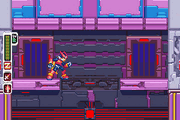
Boss Rush in Mega Man Zero (first game)
The Boss Rush system in Mega Man Zero series recycles the old idea from previous games.
Usually, it's enough to enter the capsule to automatically start the battle, but here, Zero needs to enter the capsule and then press "Up". When you finish the battle, you can go back to the start position and take two Energy Capsules.
Another difference is that the 8 Mavericks are divided into two groups of four capsules. The idea is that each group exist bosses of different elements on this classification: elec boss, ice boss, fire boss, and non-elemental boss.
Mega Man Zero - Mega Man Zero 3: Like the description, the system used in Mega Man Zero is the Neo Arcadia Teleport System, in this case, conformed for the Four Guardians and their 4 servants. It is also of note that in this game onward, you can enter the teleporter with an attack charged at the ready and preserve the charge to for use on the boss.The teleporting devices are organized like this:
----- ----- ----- -----
| A | | B | | E | | F |
----- ----- ----- -----
| Z | | Z |
----- ----- ----- -----
| C | | D | | G | | H |
----- ----- ----- -----
(The Z means the Zero Position)
(The letters represent Neo Arcadians)
Mega Man Zero 2: The Boss Rush in the Zero series which only uses 6 Mavericks, and one of them fights differently from the previous battle. Additionally, due to the difference in amount for boss of each element, the classification is different in this case:
- 1st group: Ice Boss, Non-Elemental Boss, Elec Boss
- 2nd group: Elec Bosses, Non Elemental Boss, Fire Boss
----- ----- -----
| A | | B | | D |
----- ----- -----
|Z| |Z|
----- ----- -----
| C | | E | | F |
----- ----- -----
Mega Man Zero 4: Unlike the previous Zero games, teleporters to all eight Bosses are present in a single room. An elevator is available to reach both the upper and lower levels.
----- -----
| A | | B |
----- -----
----- -----
| C | | D |
----- -----
| Z |
----- -----
| E | | F |
----- -----
----- -----
| G | | H |
----- -----
Mega Man ZX Series
The Boss Rush here is the same as in the Zero Series, in that the player has to press "Up" to start the battle, but the classification of the bosses had little differences. This is because the Pseudoroids have Elements like the Mavericks from Zero Series.
Mega Man ZX: In this case, the 8 Pseudoroids are aligned in four groups, classified based on the Biometal used.
- 1st Couple: Elec-Biometal H
- 2nd Couple: Aqua-Biometal L
- 3rd Couple: Fire-Biometal F
- 4th Couple: Non-Elemental-Biometal P
----- -----
| A | | B |
----- -----
|ZX|
(The letters represents to the Pseudoroids)
(The ZX means the Vent/Aile Position)
Mega Man ZX Advent: The Pseudoroids are aligned in only two groups. The classification is like the Zero Series in this case, because in each group exist a Boss with a different Element.
Also in this game, there's an unlockable Mini-Game "Maniac Mode" where Grey or Ashe can fight against the 8 bosses within a limit time.
A: Non-elemental boss
B: Thunder-elemental boss
C: Ice-elemental boss
D: Fire-elemental boss
----- -----
| A | | B |
----- -----
|ZX|
----- -----
| C | | D |
----- -----
(The ZX indicates the position of Grey/Ashe)
Mega Man Star Force series
This games follows the same concept as the Battle Network Series, but the concept of survival battles does not apply here.
Mega Man Star Force: In this case, the Boss Rush is played in the final day. However, all FM-ians are not included in the rematch, because a few FM-ians are "pacifist". Interestingly, Harp Note is not involved in the rematch, thought she is a boss in the storyline.
- Gemini Spark (on Earth)
- Taurus Fire, Cygnus Wing, Queen Ophiuca and Libra Scales (in the Satellite Server)
Mega Man Star Force 2: The formula is repeated in this game. However, this Boss Rush has fewer enemies compared with other Star Force games. Again, Harp Note is not involved in the rematch, but she still is a boss in the storyline, with a similar case for Hollow and Rogue.
- Dark Phantom (in the walk to Mu)
- Yeti Blizzard, Plesio Surf, Terra Condor (in Mu)
Also, if the player heads to Alternate Dimension, they can fight against all the bosses in their IF versions. In this case, all bosses are involved except Rogue.
Mega Man Star Force 3: Like the other games, the rematch is only against the official enemies; in this case, the Dealers, during the events in the final day in the Meteor G Server. However, the Mutated Wizard bosses are animated by the Dealer Cards instead of being their original selves.
- Spade Magnes (Orbital Base)
- Diamond Ice, Club Strong, Jack Corvus, and Queen Virgo (Meteor G)
If the player comes to Noise Wave 4, they can fight against all the bosses in their R forms. Also, Rogue is upgraded to Z form and optionally ZZ during this.
Other Media
- In the Archie Comics Mega Man series, Dr. Wily retrieved the defeated Robot Masters and repaired them to battle Mega Man again. However, when Mega Man tries to reason with them, the Robot Masters end up fighting against themselves and Mega Man takes the opportunity to avoid them.
- In Rockman: Dr. Wily no Inbou, Metal Man informs Mega Man that Dr. Wily made a backup of his eight robots, and Mega Man must face them again.
- In the Rockman 6 manga, the eight bosses are Copy Robots.

